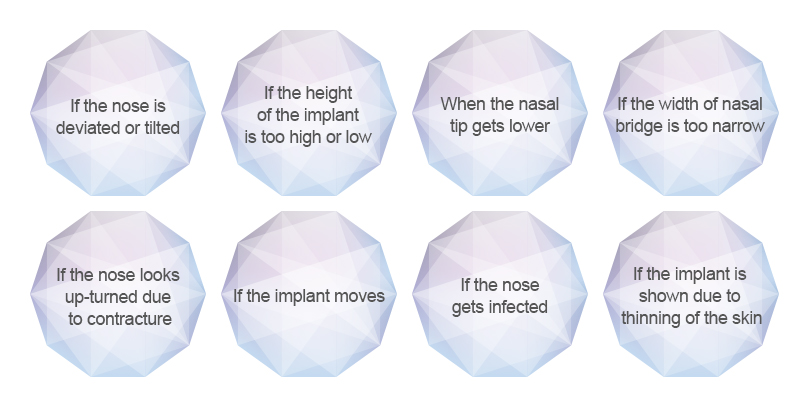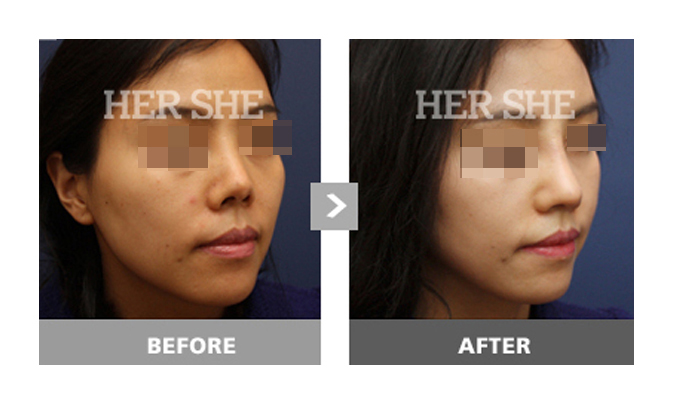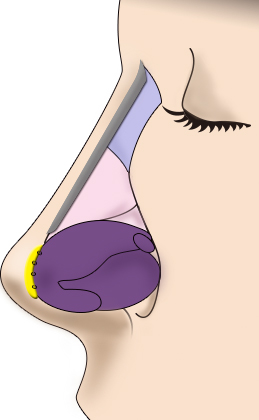- Nose Revision
- HOME > HERSHE Plastic Surgery & Dermatology Nose > Nose Revision

About nose revision surgery
Nose revision surgery, which commonly involves removal and/or replacement of previous implants and redesigning of the overall nose figure, is performed to change the overall shape of the nose and size or type of the implant to correct any complications and dissatisfaction from the previous nose surgery. Nose revision surgery should be considered for various reasons such as, if the former nose surgery caused thinning of the skin and/or infection, and/or if the height and position of the implant is not satisfying, or if the implant moves, and/or if the nose become tilted and/or deformed. Revision nose surgery is much more complicated than the initial surgery as previous surgery leaves scar tissue inside the nose. Hence, it is important to have thoughtful consideration prior to the decision, and sufficient consultation with systemically planned nose surgery by experienced plastic surgeon. |
When to consider nose revision surgery
Patients often hesitate nose revision surgery because of its complication. Mostly it is due to anxiety and distrust from the failure of nose surgery. However, it is important to get over from the emotional anxiety, and have trust and confident on revision surgery that you can achieve improvement from the revision surgery. Apart from the reasons of revisionsurgery, it is better to do revision surgery within 1 to 2 weeks right after the surgery, or at least 6 months after the surgery. In case of simple rhinoplasty (nasal dorsum augmentation), the revision surgery could be proceeded after 3 months. However, The appropriate time for the revision surgery is highly depending on the condition of the patient, and it is best performed least 6 months to a year after 1~2 weeks has passed. The purpose of the waiting is to give sufficient healing period for nose tissue to fully recover and the scar tissue to get softened. However, revision surgery should be conducted right away for the following reasons; 1. If inflammation takes place after the surgery. 2. If the implant is deviated after the surgery. 3. If the nasal skins gets thinner and red and the implant has chance to puncture the nasal skin. |
Recommend to

How to avoid revision surgery and dissatisfaction
Since nose is complex structure formed with different inner structures and parts, formation of nose in three dimensional aspects need to be considered prior to the surgery. Augmentation of the nose without considering the facial ratio will not improve the appearance, as height and shape of the nose needs to be balanced with overall facial features. The size of alar rim base is related with the distance between the eyes, and the ideal height of the nose should be determined carefully based on the degree of projection of the forehead and chin. Beautiful nose does not necessarily mean high and pointy nose, but nose with sleek and natural curve line from the root of the nose to the nose tip that is balanced with other features of the face. Dissatisfactory can also take place even if the surgery was done perfectly due to the personal preferences. Hence, it is most important to clearly reveal personal preference, desired result after the surgery and understand what is possible and suitable during the consultation in order to achieve the desired shape of nose with high satisfaction. |
About HERSHE nose revision
01.If the nose is deviated or tilted When the shape of the implant is
deformed orwhen the implant is positioned in the unintended position, the nose
becomes deviated and tilted. In this case, the shape of the
nose can be corrected by replacing the implant or redesigning the implant
shape. Enough space over the nose bridge for the implant should be created and
the implant should be fixed with the nasal cartilage to prevent deviation. |
|
|||
02. If the height of the implant is too high or low When there is hump on the nasal bridge and rhinoplasty was conducted without hump removal, silicone will be placed over the hump which makes nasal bridge too high. In this case, hump should be removed with shaving method or fracture based on the degree of hump. Also, implant should be changed with thinner implant. |
||||
|
03. When the nasal tip gets lower Nasal
tip is consist of soft cartilage different to the nasal bridge, hence, nasal
tip can be lowered 1 to 2 years after the surgery |
|
|
|
|
4. If the width of nasal bridge is too narrow The ideal width of nasal bridge is 1cm and should be slimmer than the width of nasal tip. If the width of nasal bridge is too narrow, it gives unnatural impression and nasal tip can be appeared as more round and blunt. In this case, nose the bridge implant should be changed and the width of implant should be bit wider than former implant. |
|
||
|
05. If the nose looks up-turned due to contracture When an extreme implant surgery was performed, or the contracture was found, the implant will be pulled upward lifting the tip of the nose. In this case, the implant and some of the contracted skin tissue should be removed. After that, nasal tip should be reconstructed with ear cartilage and the septum cartilage. |
|
|
|
|
06. If the implant moves When the implant is inserted right beneath the skin instead of the peritoneum, the implant can move as it does not match the natural curve of the nose. In this case, existing implant should be removed and new implant should be placed in between the peritoneum and the nasal bone and fixed to prevent migration. |
|||
7. If the nose gets infected and/or an allergic reaction caused Foreign body reaction can cause the skin of the nose to turn red or develop other signs of infection. The implant should be removed and plan re-operation 6 months later if the symptom is severe. |
|
|||
|
|
8.If the implant is shown due to thinning of the skin The skin of the nose could turn red when a stiff implant is inserted into the very upper layer of the nose skin. In this case, the skin will get thinner and capillaries become visible from the outside. In this case, the implant can be replaced, or dermisand artificial dermis can be added. |
Process of nose revision surgery
|
|
|
|||
01. Failure from the previous surgery will be closely analyzed and appropriate surgery methods will be decided according to each patient prior to the surgery. |
|||||
> |
02. Design considering new nasal bridge curve line and preserve skin tissue by precise skin tissue detachment. | ||||
|
| > | 03. Implants from the former surgery will be removed; both of ear and septum cartilage will be used to shape the natural tip and desirable nasal bridge. |
| |
|
| ||||
|
| ||||
| Post operation care | |
| | Wipe the surgical area with a soft tissue. The swelling and bruising could get worse than the other surgery before and will last up to 1~2 weeks. Heavy swelling can be found within 24 hours after the operation. Apply cold compresses to reduce swelling. | |
Before & After




- Consultation: +82 10 3420 4624 Email: hershe.eng@gmail.com
- HERSHE Plastic Surgery, 2~4 floor, 63-12 Cheongdam-dong Gangnam-gu, Seoul, South Korea | Registration number : 211-09-46633|
TEL: 02.546.9526 / FAX: 02.511.9970| Business Name: HERSHE Plastic Surgery | Business Holder: Jung Young Choon



















